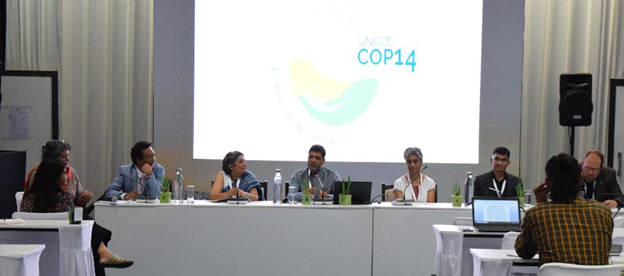
India finally announced that it would increase its targets of restoring degraded lands from 21 million hectares to 26 million hectares[1]. This target comes on the heels of weeks of conjecture on the "big announcement" expected from the host country during the UNCCD COP14 meeting in Delhi.
While the Indian Prime Minister's address during the high-level segment on 9th September was greeted with some enthusiasm, the brief summary was slim on details such as the strategy to achieve the target or mention of India's transformative project with regard to land degradation neutrality.
One way to put the target of 26 million ha into perspective is to compare it with the scale of land degradation in India at the moment. An ISRO report from 2016 estimates the extent of land degradation in India at 96.4 million hectares, representing around 30% of the country's total land area[2].
Are the targets achievable?
The statement of "increasing the target from 21 mha to 26 mha" refers to India’s earlier Bonn Challenge target announced in 2015[3]. As per this target, India was to restore 13 mha by 2020 and a further 8 mha by 2030.
As per an IUCN assessment in 2018, India had restored around 9.8 million hectares between 2011 and 2018. This was due to the increased focus on restoration brought in by the Bonn challenge – a global effort to restore 350 million hectares by 2030[4].
A back of the envelope calculation suggests that this rate of restoration corresponds to about 1.4 mha per year since 2011. At this rate, India is likely to restore an additional 15 to 16 million hectares by 2030, taking the total to about 26 million hectares from 2011 – exactly India’s LDN target announced on September 9th. So the question of whether India will be able to meet it is quite clear; this level of effort has been demonstrated and hence should not be a challenge.
The scale of the challenge in India
The ISRO report referred to earlier shows that the states of Rajasthan, Gujarat, Maharashtra, erstwhile Jammu & Kashmir and Karnataka have the highest area of lands undergoing degradation, covering about two thirds of the total degraded area of 96.4 mha that it mentions. Rajasthan has the highest degraded area (21.53 mha) followed by Maharashtra (13.83 mha).
Financing land degradation neutrality is another challenge for most developing countries. While international mechanisms such as the LDN fund[5] cover a very small fraction of the global estimates for the cost of land degradation[6], it is essential that these countries – especially those in land degradation hotspots such as South Asia and Africa – have a strong national strategy and supporting policies in places to address the issue.
India does have several policies linked to sustainable land management, such as the National Water Policy 2012; National Policy for Farmers 2007; National Livestock Policy 2013; National Environment Policy 2006; National Biodiversity Action Plan 2008 and the National Action Plan on Climate Change 2008, to name a few. There is, however, still a need to consider land-use patterns and drivers of land-use change holistically and find a way to harmonise these policies at state and central levels[7].
Efforts of the Watershed Organisation Trust (WOTR) to combat land degradation and desertification
WOTR was initiated to support a large-scale multi-actor, multi-sectoral, community led watershed development program for poverty reduction called the Indo-German Watershed Development Program (IGWDP) in 1993. WOTR has since been involved in watershed development in about 530 villages, covering 325,243 ha and impacting over 5 lakh people. In addition, it has worked on soil and water conservation through the MGNREGA programme in 213 villages, impacting an additional 3.5 lakh people.
The experiences and learnings from these projects were influential in the set-up of the Watershed Development Fund (WDF) with NABARD and also contributed to the Common Guidelines for Watershed Development Projects 2008[8] – critical instruments to address drought and land degradation in the country today. WOTR is also involved in a number of applied research and policy advocacy projects such as Ecosystem based Adaptation (EbA), Soil Protection and Rehabilitation of Degraded Soil (ProSoil) and Economics of Land Degradation (ELD).
These projects are aimed at generating evidence, linking science, policy and practice, and also finding 'windows of opportunity' for effective policy engagement. WOTR’s participation in the UNCCD COP14 and hosting a side-event that brought together experts from the Ministry of Agriculture, researchers, representatives of international aid agencies such as the German Agency for International Cooperation (GIZ), national and international NGOs and think-tanks – like the ELD Initiative, Development Alternatives – is one such action in this regard.

WOTR and its Centre for Resilience Studies (W-CReS) are committed to ensure that "communities, especially the poor within, are empowered to live in dignity and secure their livelihood in sustainable ecosystems".
What is land degradation?

According to the United Nations Convention to Combat Desertification, land degradation is the "reduction or loss in arid, semi-arid and dry sub-humid areas, of the biological or economic productivity and complexity of rainfed cropland, irrigated cropland or range, pasture, forest and woodlands resulting from land uses or from a process or combination of processes, including processes arising from human activities and habitation patterns such as: soil erosion caused by wind and/or water; deterioration of the physical, chemical and biological or economic properties of soil; and long-term loss of natural vegetation".
When land degradation occurs in dryland areas, more specifically arid, semi-arid and dry sub-humid areas, it is referred to as desertification. Around 69% of India falls under drylands.
Arjuna Srinidhi, is a Senior Researcher at WOTR Centre for Resilience Studies (W-CReS)
Disclaimer: The views and opinions expressed in this article are those of the author/s and do not necessarily reflect the policy or position of India Water Portal.
/articles/indias-target-combat-land-degradation-and-desertification